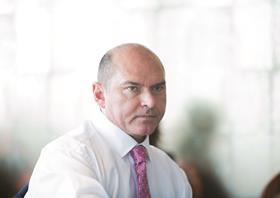- NHS Improvement chief executive says provider sector will fail to break even in 2017-18
- Sector could break even next financial year but factors are beyond trusts’ control, says Jim Mackey
- Discussions taking place about reporting on the joint financial performance of the NHS provider and commissioning sectors
The chief executive of NHS Improvement has admitted that a key financial target that was seen as “critical” to the progress of the Five Year Forward View will not be met.
In an interview with HSJ, Jim Mackey said the NHS provider sector will not break even again in 2017-18, and reaching financial balance in 2018-19 will depend on factors outside trusts’ control.
Mr Mackey said suggestions that the trust deficit would be between £500m and £600m in 2017-18 were “not miles out”, though efforts are being made to reduce this.
Asked about the lack of detailed financial information in last week’s Next Steps on the Five Year Forward View, Mr Mackey said: “I think that’s been a legitimate criticism. Ideally I’m a manager so I would have liked to have seen some of that detail completely signed off by our board, signed off by NHS England’s board, and the Treasury and Department of Health comfortable with it…
“But we’re just not at that point because we’re still in the muck and bullets of it all.”
Mr Mackey pointed to the “many moving parts” that make the financial recovery uncertain, such as the level of benefit that trusts will experience through the uplift in social care funding, and said many people in the system will feel breaking even in 2018-19 is not possible either.
He added: “The provider sector won’t be in balance in 2017-18. It’s possible to get there in 2018-19, ceteris paribus and all that. But we’re not in control of all those other things.” He said even the timetable to achieve overall balance in 2018-19 was ”very, very risky”.
However he said: “[But] the deficit has dropped quite a lot in aggregate and quite a lot in the number of institutions, so the next bit is about how we corral the risk in the group as a whole and make sure we don’t do a bit over here that causes damage over there… Part of that means there’s going to have to be some really hard decisions.”
NHS trusts are forecast to end 2016-17 with a deficit of £873m, against the planned £580m deficit and “stretch target” of £250m.
Last week HSJ asked NHS England chief executive Simon Stevens whether it was possible to meet the expected £30bn funding gap in 2020-21, which was set out in the forward view, given that providers are unlikely to be in balance as planned.
He said: “The conversation we are all focused on is 2017-18 and 2018-19. We are two years on from the forward view and last year and this year, the NHS in round will have balanced our books…
“So the point is this is not a kind of a number for its own sake, it’s just a way of describing the pressures that we have to deal with relative to the funding that we have got.
“So we have just got to keep putting points on the board. If we can make 2017-18 work, then we will have done that for three years.”
Commissioners and providers could report combined performance
Discussions are taking place about reporting on the joint financial performance of the NHS provider and commissioning sectors, Jim Mackey told HSJ.
He said: “I think [the Treasury] do get a bit frustrated with how all the moving parts of the group work and that’s a weakness for us, which we’re all working harder at.
“I think it’s a bit odd that we report separate segments separately, the provider side separate from the commissioner side…
“I’d rather do [a quarterly update for the NHS as a whole]. We haven’t agreed it yet, but I think in initial discussions most people would support the principle of doing that. There’s a general trend to move away from the commissioning pipe and the provider pipe and we need to reflect that better.
“It’s a more useful public message and it actually shows a better position, because everybody naturally gets focused on the bits that are adrift rather than the bits in surplus.”
Mackey: 'We dropped a clanger' on agency staff rules
- 1
- 2
 Currently reading
Currently readingExclusive: Mackey admits trust deficit cannot be cleared in 2017-18
- 3
- 4
- 5
- 6

































11 Readers' comments